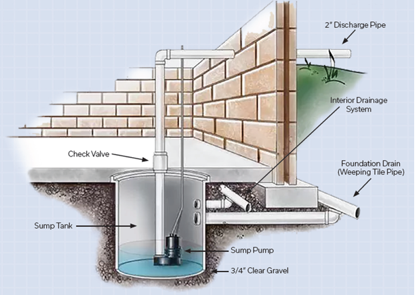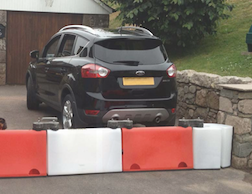There are numerous defences available to prepare your home for floods. Solutions employed both inside or outside your house can be extremely useful in a flooding event and can greatly reduce the stress involved in managing flood risks and damages. These flood defences are often listed on municipal websites or in articles that cover flooding. As a homeowner, it may be useful or interesting to learn about their functions a bit more and how they work.

A common flood prevention measure is to install a sump pump, a device recommended to many homeowners. The purpose of a sump pump is to move water away from your home’s foundation, directing it into the sewer system or onto your lawn. Sump pumps are placed into a “sump pit”, located in the basement of your home. The sump pump detects water using a flotation or pressure sensor and this causes the pump to start up and move water out and away from your home.
During a flood, sewer mains can experience backup causing the sewer water to enter your home through the drains. To prevent this, backwater valves can be installed, acting as a barrier to water moving in the wrong direction, while still allowing water to move towards the sewer. Installation should be completed by a plumber to ensure the valve will work properly in the event of a backup.
To prevent water from collecting at your home’s foundation, properties can be re-graded, which involves angling the land towards a sewer or permeable surface, such as a garden. To get started on this project you can contact a local professional for advice on regrading. It is important to identify any construction regulations to ensure the job can be completed. Once confirmed, you can hire a contractor to regrade your property. This is another great way to increase your home’s flood preparedness.

Other property-level flood defences include rain barrels and rain gardens, which can be used to slow down and stop water around your home. In the case of severe flooding or emergencies, small-scale barriers or dams can be placed around your property, on a temporary basis, to prevent floodwaters from approaching your home. You could also choose to use water-inflated barriers or small-scale plastic dams in a flooding event. These defences have the same effect as sand bags but are a more structural option that can be easily deployed.
By understanding how these defences work, you can be confident in creating effective flood defences for your home. Your municipality or province may have incentive programs available to assist with funding these measures, making for an easier preparation process. You can contact your local officials to learn more about what might be available in your region and to learn even more about possible flood preparations.
Image Sources:
Barrier Solutions. (n.d.). Floodstop Barriers of Canada. Retrieved December 3, 2018, from http://www.floodstopbarrier.ca/
City of Windsor. (2018). Sump Pump with Overflow. Retrieved December 3, 2018, from https://www.citywindsor.ca/residents/environment/climate-change-adaptation/climate-resilient-home/Pages/Sump-Pump-with-Overflow.aspx